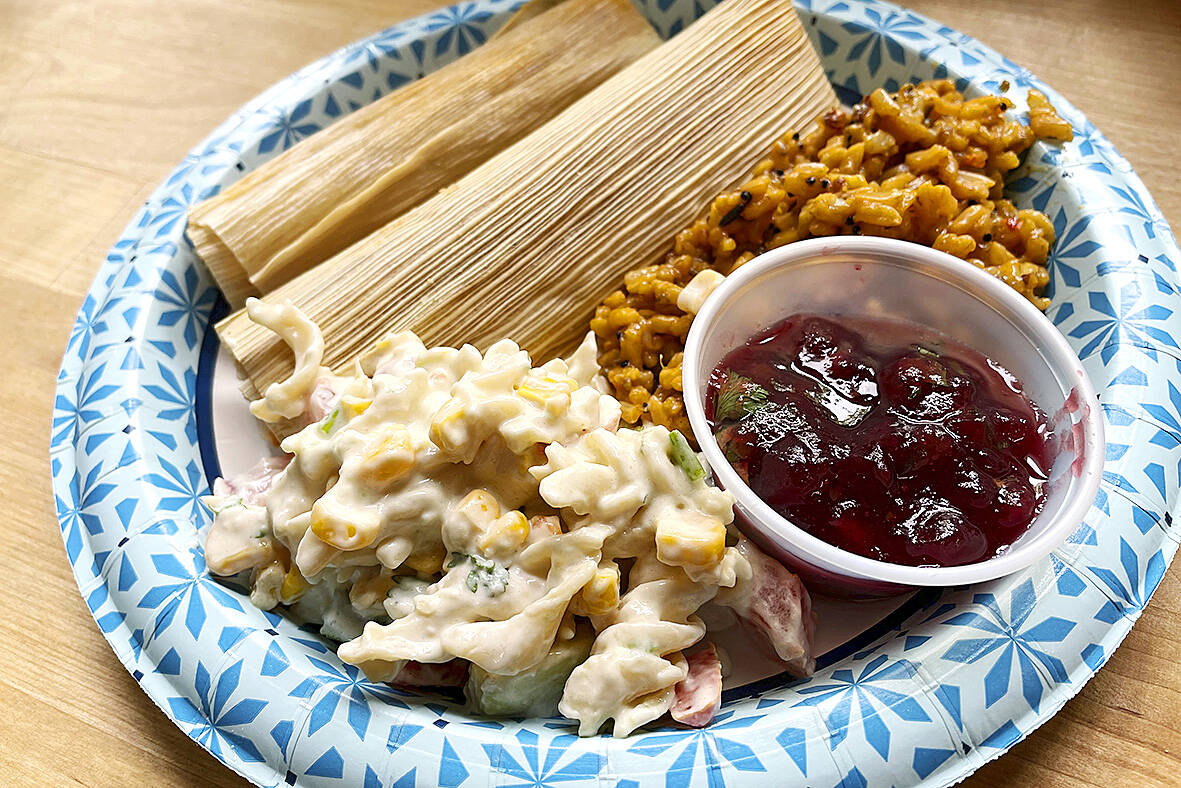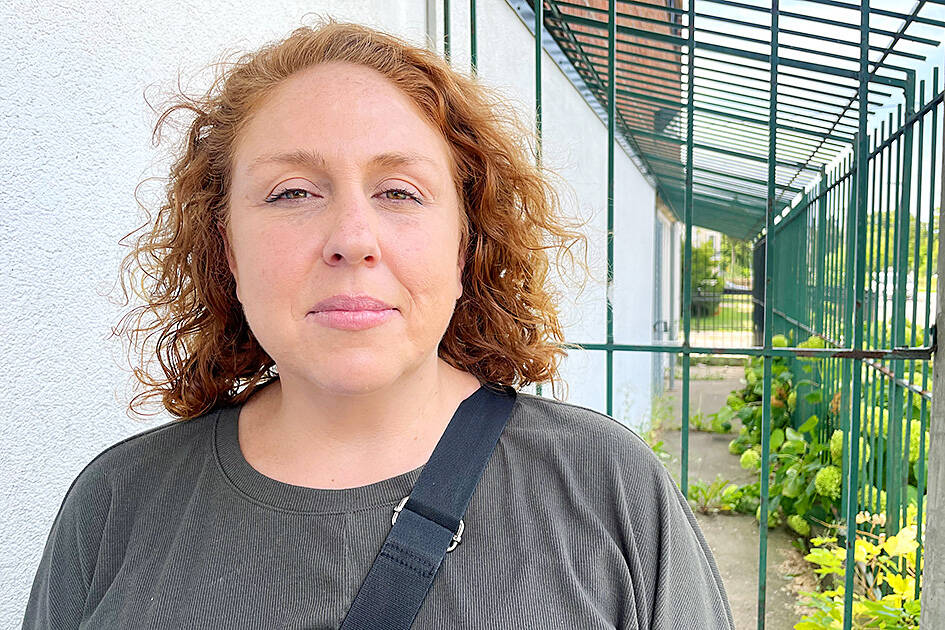Blueberry bison tamales, harvest salad with mixed greens, creamy carrot and wild rice soup, roasted turkey with squash. This contemporary Native American meal, crafted from the traditional foods of tribes across the US and prepared with ketapanen — a Menominee expression of love — cost caterer Jessica Pamonicutt US$976 to feed a group of 50 people last November.
Today it costs her nearly double.
Pamonicutt is the executive chef of Chicago-based Native American catering business Ketapanen Kitchen. She is a citizen of the Menominee Indian Tribe of Wisconsin but was raised in the Windy City, home to one of the largest urban Native populations in the country, per the American Indian Center of Chicago.

Photo: AP
Her business aims to offer health-conscious meals featuring indigenous ingredients to the Chicago Native community and educate people about indigenous contributions to everyday American fare.
One day, she aims to purchase all ingredients from Native suppliers and provide her community with affordable access to healthy indigenous foods, “but this whole inflation thing has slowed that down,” she said.
HEALTH BENEFITS

Photo: AP
US inflation surged to a new four-decade high in June, squeezing household budgets with painfully high prices for gas, food and rent.
Traditional indigenous foods — like wild rice, bison, fresh vegetables and fruit in the Midwest — are often unavailable or too expensive for Native families in urban areas like Chicago, and the recent inflation spike has propelled these foods even further out of reach.
Risk of disease compounds the problem: healthy eating is key to battling diabetes, which afflicts Native Americans at the highest rate of any ethnic group in the US.
“There are many benefits to eating traditional Native foods,” said Jessica Thurin, a dietician at Native American Community Clinic in Minneapolis.
“The body knows exactly how to process and use that food. These foods are natural to the Earth.” But many people the clinic serves are low-income and do not have the luxury of choosing where their food comes from. Food deserts — areas with limited access to a variety of healthy and affordable foods — are more likely to exist in places with higher rates of poverty and concentrations of minority populations.
“In these situations, there are limited healthy food options, not to mention limited traditional food options,” Thurin said.
Aside from health benefits, traditional foods hold important cultural and emotional value.
“It’s just comfort,” said Danielle Lucas, a 39-year-old descendant of the Sicangu Lakota people from the Rosebud Sioux Tribe in South Dakota.
Lucas’ mother, Evelyn Red Lodge, said she hasn’t prepared traditional dishes of the Great Plains, like wojapi berry sauce or stew, since May because the prices of key ingredients — berries and meat — have soared.
Pamonicutt, too, is feeling the pinch. Between last winter and this spring, the price of bison jumped from US$13.99 to US$23.99 per pound.
Shipping costs are so high that the chef said it’s often cheaper to drive hundreds of kilometers to buy ingredients, even with spiking gas prices. She’s even had to create her own suppliers: the 45-year-old’s parents are now growing crops for her business on their Wisconsin property near the Illinois border.
Gina Roxas, program coordinator at Trickster Cultural Center in Schaumburg, Illinois, a Chicago suburb, has also agreed to grow Native foods to help the chef minimize costs.
When a bag of wild rice costs US$20, “you end up going to a fast food place instead to feed your family,” Roxas said.
SPENDING DECISIONS
More than 70 percent of Native Americans reside in urban areas — the result of decades of federal policies pushing families to leave reservations and assimilate into American society.
Dorene Wiese, executive director of the Chicago-based American Indian Association of Illinois, said members of her community have to prioritize making rent payments over splurging on healthy, traditional foods.
Even though specialty chefs like Pamonicutt aim to feed their own communities, the cost of her premium catering service is out of the price range for many urban Natives. Her meals end up feeding majority non-Native audiences at museums or cultural events that can foot the bill, said Wiese, a citizen of the Minnesota White Earth Band of Ojibwe Indians.
“There really is a shortage of Native foods in the area,” she said, But the problem isn’t unique to Chicago.
Dana Thompson, co-owner of The Sioux Chef company and executive director of a Minneapolis Indigenous food nonprofit, is another Native businesswoman striving to expand her urban community’s access to traditional local foods like lake fish, wild rice and wild greens amid the food price surge.
Thompson, of the Sisseton Wahpeton Oyate and Mdewakanton Dakota people, said inflation is “really impacting the food systems we have here,” which include dozens of indigenous, local and organic food producers.
At Owamni, an award-winning Indigenous restaurant under The Sioux Chef umbrella, ingredients like Labrador Tea — which grows wild in northern Minnesota — have been especially difficult to get this year, Thompson said.
When an ingredient is not consistently available or affordable, she changes the menu.
“Being fluid and resilient is what we’re used to,” Thompson said. “That’s like the history of indigeneity in North America.”
FOOD SECURITY
Inflation is similarly impeding the American Indian Center of Chicago’s efforts to improve food security. Executive Director Melodi Serna, of the Turtle Mountain Band of Chippewa Indians and the Oneida Nation of Wisconsin, said the current prices of food boxes they distribute — with traditional Midwestern foods like fish, bison, venison, dairy products and produce — are “stronomical. “Where I could have been able to provide maybe 100 boxes, now we’re only able to provide 50,” Serna said.
For 57-year-old Emmie King, a Chicago resident and citizen of the Navajo Nation, getting the fresh ingredients she grew up with in New Mexico is much more difficult in the city, especially with inflation biting into her budget.
She finds ways to stretch the food she buys so it lasts longer, purchasing meat in bulk and freezing small portions to add to stews later on. “I get what I need, rather than what I want,” she said.
But King was able to enjoy a taste of home at an Aug. 3 luncheon at the American Indian Center of Chicago, where twenty elders gathered to enjoy turkey tamales with cranberry-infused masa, Spanish rice with quinoa, elote pasta salad with chickpea noodles and glasses of cold lemonade.
The mastermind behind the meal was Pamonicutt herself, sharing her spin on Southwestern and Northern Indigeneous food traditions. Through volunteering at senior lunches and developing a food education program, the chef is continuing to increase access to healthy Indigenous foods in her community.
“I want kids to learn where these foods come from,” the chef said. “That whole act of caring for your food. Thanking it, understanding that it your food … thanking it, understanding that it was grown to help us survive.”

Oct. 27 to Nov. 2 Over a breakfast of soymilk and fried dough costing less than NT$400, seven officials and engineers agreed on a NT$400 million plan — unaware that it would mark the beginning of Taiwan’s semiconductor empire. It was a cold February morning in 1974. Gathered at the unassuming shop were Economics minister Sun Yun-hsuan (孫運璿), director-general of Transportation and Communications Kao Yu-shu (高玉樹), Industrial Technology Research Institute (ITRI) president Wang Chao-chen (王兆振), Telecommunications Laboratories director Kang Pao-huang (康寶煌), Executive Yuan secretary-general Fei Hua (費驊), director-general of Telecommunications Fang Hsien-chi (方賢齊) and Radio Corporation of America (RCA) Laboratories director Pan
The consensus on the Chinese Nationalist Party (KMT) chair race is that Cheng Li-wun (鄭麗文) ran a populist, ideological back-to-basics campaign and soundly defeated former Taipei mayor Hau Lung-bin (郝龍斌), the candidate backed by the big institutional players. Cheng tapped into a wave of popular enthusiasm within the KMT, while the institutional players’ get-out-the-vote abilities fell flat, suggesting their power has weakened significantly. Yet, a closer look at the race paints a more complicated picture, raising questions about some analysts’ conclusions, including my own. TURNOUT Here is a surprising statistic: Turnout was 130,678, or 39.46 percent of the 331,145 eligible party

The classic warmth of a good old-fashioned izakaya beckons you in, all cozy nooks and dark wood finishes, as tables order a third round and waiters sling tapas-sized bites and assorted — sometimes unidentifiable — skewered meats. But there’s a romantic hush about this Ximending (西門町) hotspot, with cocktails savored, plating elegant and never rushed and daters and diners lit by candlelight and chandelier. Each chair is mismatched and the assorted tables appear to be the fanciest picks from a nearby flea market. A naked sewing mannequin stands in a dimly lit corner, adorned with antique mirrors and draped foliage

The older you get, and the more obsessed with your health, the more it feels as if life comes down to numbers: how many more years you can expect; your lean body mass; your percentage of visceral fat; how dense your bones are; how many kilos you can squat; how long you can deadhang; how often you still do it; your levels of LDL and HDL cholesterol; your resting heart rate; your overnight blood oxygen level; how quickly you can run; how many steps you do in a day; how many hours you sleep; how fast you are shrinking; how